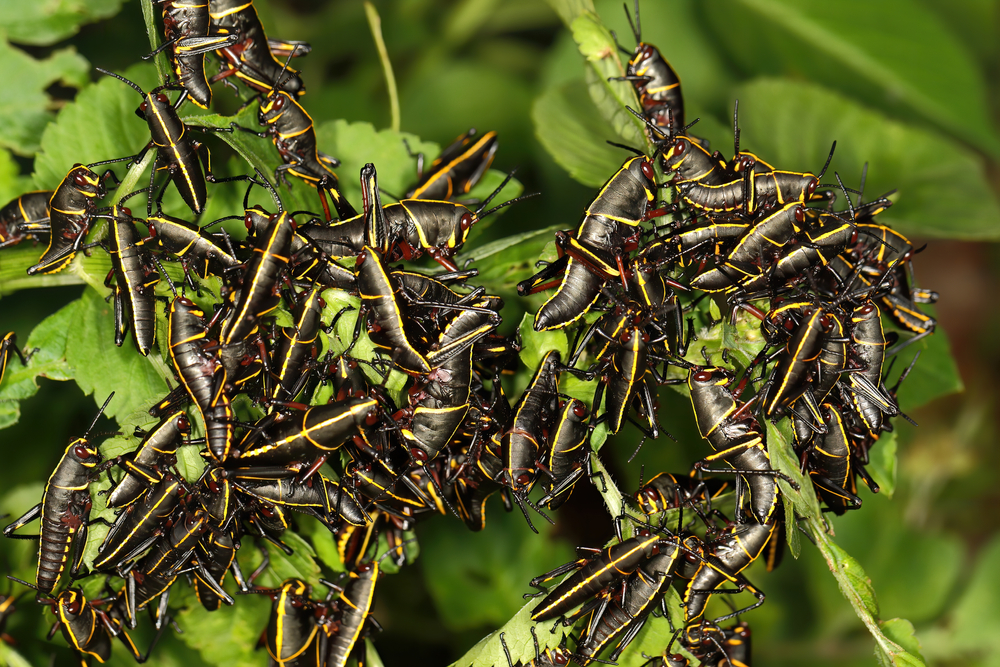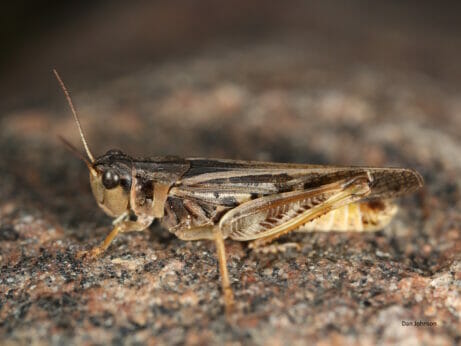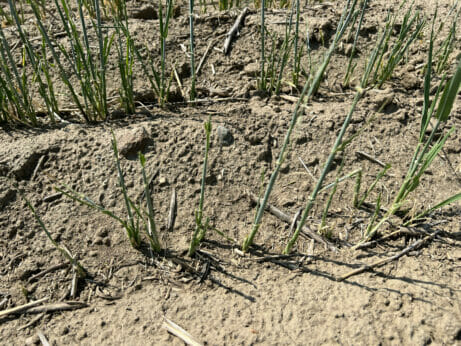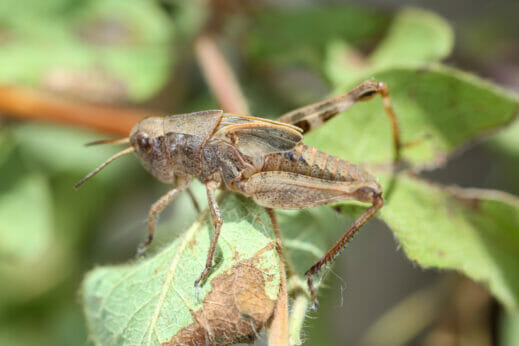Thriving in the heat and dry conditions of a continuing drought, grasshoppers in southeastern Alberta are eating their way through farmers’ fields. Is there any stopping them?

Every August, the Alberta government surveys grasshopper populations to discern the number of adult females capable of reproduction and egg-laying. Based on these tallies, the following year’s grasshopper population is calculated.
But in 2022, the data was stark: Researchers warned of severe grasshopper infestations in southern Alberta and along the Saskatchewan border. But without much-needed rain, there was very little that could have been done to hold back the hungry hordes.
Dan Johnson is a professor of environmental science at the University of Lethbridge in Alberta. “Grasshoppers are very responsive to weather,” he says.

A male clearwing grasshopper. Photography courtesy of Dan Johnson.
Females lay their eggs in late summer, sometimes as many as eight pods of between 10 and 90 eggs each. If it’s a wet fall, fungi and bacteria can infect the eggs, limiting their survival rates. If it’s a warm spring, the eggs will hatch early, and the nymphs can develop quickly. In southeastern Alberta, three years of warm springs and long dry summer and fall months have created the perfect conditions for egg laying and population growth.
“The irony,” says Johnson, “is that there are about 80 common species of grasshoppers and only a handful are bad guys. The rest are beneficial to the ecosystem, devouring invasive weeds and providing food for prairie birds like the endangered burrowing owl. In Alberta, it’s the clear-winged and two-striped grasshoppers that are causing all the damage.”
Just 10 of these “bad guys” per square metre can consume between 16 percent and 60 percent of available vegetation. Their meals of choice are: barley, oats, corn, soy, wheat, rye and alfalfa, the mainstay commercial crops of prairie farmers.
Unfortunately, prevention isn’t as easy as spraying the larvae with pesticides. “Spraying has to be targeted, and unless you know the difference between the larva of the bad versus good grasshopper, which many people don’t, spraying can be ineffective,” says Johnson. Then, once the insects start eating, it’s too late to fight back. “Insecticides can deter some of them, but when the numbers are as high as they are now, it’s pretty much impossible to eradicate them all.”
Even if a farmer does spray, there’s often a wait time between the application of a chemical pesticide and when it’s safe to harvest a crop. This means farms have to keep the crop alive and use up precious water resources in an already water-restricted environment.

Crops devoured by grasshoppers. Photography courtesy of Dan Johnson.
Stewart Wells is a third-generation farmer and owner of Penny Lane Organic Farms in Swift Current, SK. The farm’s organic certification means he is unable to use synthetic pesticides, so he instead relies on natural controls for his wheat, lentils, peas, alfalfa, mustard and coriander. While most of what he’s growing are traditional cash crops, the coriander isn’t for commercial sale. It’s for the grasshoppers. “They don’t like the smell and will avoid areas where it’s planted,” he says. Does it work? “Moderately.” Unfortunately, there aren’t many other proven methods to use. Wells could try to seed his crops early, so they can be harvested before the nymphs mature into eating machines. But that’s tricky. Farmers need warm weather to seed, and the warmer it gets, the faster the nymphs grow.
It all adds up to a smorgasbord for the hungry insects.
Justine Comeau is an agricultural fieldman for southeastern Alberta’s Special Areas Board. An agency of the Government of Alberta, the board acts as a rural municipal service and, during a crisis, provides support to residents of the region. “Many of us remember the drought of the early 2000s and how grasshoppers ate the siding off houses. They were everywhere—even roads and highways had to be closed. This year is almost as bad,” she says.
Across North America, farmers and ranchers are telling similar stories. In 2022, Oregon had an estimated 5.3 million acres of farm and ranchland infested by destructive grasshoppers. In some places, the average density was estimated at 73 grasshoppers per square yard. The United States Department of Agriculture sets a threshold of 15 to 20 nymphs or 8 to 10 adults per square yard before economic damage occurs.
“The financial impact of Alberta’s 2023 grasshopper infestation will vary from zero to 100 percent loss, depending on the area,” says Comeau. “There are pockets where there are none and, in other areas, 100 per square metre.
“For many livestock producers, the few grazing areas left that haven’t dried up because of lack of water have now been eaten by the grasshoppers,” says Comeau. The situation has become so serious that ranchers are having to destock herds.” It will take years for the pastures and perennial forages to recover, and that’s only if conditions improve. In the meantime, the costs and damages keep adding up. The effects of the 2001-2002 drought and all its combined losses, including grasshopper damage, cost the Canadian economy $5.8 billion.

An immature clearwing grasshopper. Photography courtesy of Dan Johnson.
The effects of this drought could be even more far-reaching. Alberta exports seven million tons of wheat each year to 70 countries around the world. With supplies of wheat already hampered by the Russian invasion of Ukraine, a blow like this could put another dent in an already dwindling supply.
In July, the Special Areas Board declared an agricultural disaster in southeastern Alberta, in hopes of making it easier for producers to get financial help from the province and access crop insurance claims. It will help, but it won’t solve the overall problem. If the hoped-for rains come and the drought abates, it won’t be the last time farmers and ranchers will have to deal with apocalyptic hordes of grasshoppers. According to the Government of Alberta’s climate change website, elongated periods of hot and dry weather are predicted to become more frequent in the province and to last longer because of climate change.
Along with the heat and arid conditions, there will be grasshoppers.
Do grasshoppers have a mating call which might be deployed to capture them en mass? What potential markets are there for mass quantities of captured grasshoppers?
During a peak in grasshopper populations in Montana a wise old rancher sold cows he was willing to cull and used the money to buy hundreds of turkeys. He modified livestock trailers to house the turkeys at night. Hired a few people to watch the turkeys during the day. When November rolled around he made a profit and was able to buy well bred heifers the next spring. He even said that he was somewhat sorry to see all those grasshoppers go.
Mobile turkey houses, ala Joe Salatin are worth a look. They would have to be taller, bigger and pulled by a tractor (maybe) but they just might work. Google how to get in touch with Joe Salatin or go to his YouTube channel. Or already tried and true chicken houses with chickens if they will eat the grasshoppers and they are moveable by two people without a tractor. Hope this can help.
What all have people been doing to increase the threat of these impacts? What can non farmers do to help out the issue?